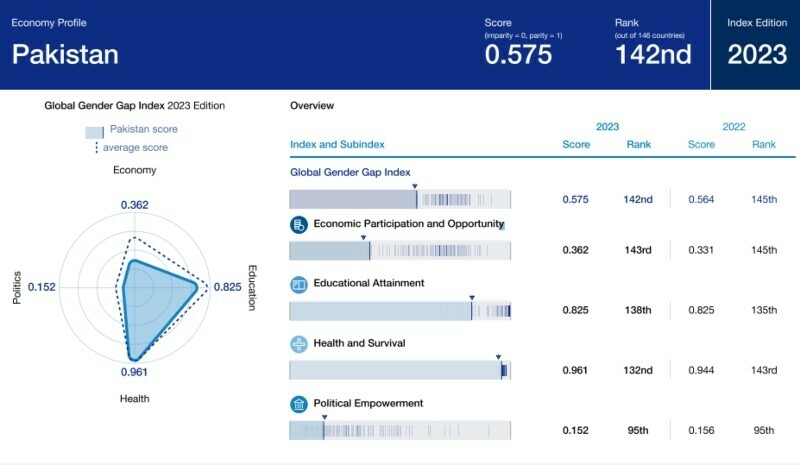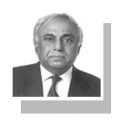By Amin Ahmed
Published in Dawn on June 21, 2023
In the World Economic Forum’s (WEF) Global Gender Gap Report 2023, Pakistan has been ranked 142 out of 146 countries — with a 57.5 per cent gender parity — the highest since 2006.
The annual report benchmarks the current state and evolution of gender parity across four key dimensions: economic participation and opportunity, educational attainment, health and survival, and political empowerment.
In the report, which was released on Wednesday, Pakistan has been placed near the bottom of both the regional and global rankings. Only Iran, Algeria, Chad and Afghanistan are below Pakistan. In 2022, Pakistan ranked 145 out of 146.
However, the country has improved by 5.1 percentage points on the “economic participation and opportunities” sub-index in the last decade to attain 36.2 per cent parity, though this level of parity remains one of the lowest globally, the report pointed out.
Economic participation and opportunity
Pakistan ranked 143rd in the sub-indicator of economic participation and opportunities. The country ranked 140th in terms of labour-force participation, 71st in terms of wage equality for similar work, 137th in terms of estimated earned income, 139th in terms of legislators, senior officials and managers, and 132nd in terms of professional and technical workers.

Educational attainment
Pakistan’s ranking in the educational attainment dimension was 138th in 2023. The country’s literacy rate is 137th, and its enrolment rates in secondary and tertiary education are 132nd and 104th, respectively.

Health and survival
With a ranking of 132nd in health and survival, the sex ratio at birth (male births per female births) is first while healthy life expectancy is at 140.

Political empowerment
In the political empowerment dimension, Pakistan ranked 95th. It ranked 94th for women in parliament, 126th for women in ministerial positions, and 36th for years with female/male heads of state during the last fifty years.

Progress
For Pakistan, there is broad progress across all indicators on the economic participation and opportunity sub-index, particularly in the share of women technical workers and the achievement of parity in wage equality for similar work.
Despite relatively high disparities, parity in literacy rate and enrolment in secondary and tertiary education are gradually advancing, leading to 82.5 per cent parity on the educational attainment sub-index.
Pakistan secured parity in sex ratio at birth, boosting sub-index parity by 1.7 percentage points since 2022. Like most other countries, Pakistan’s widest gender gap is on political empowerment (15.2 per cent).
It has had a female head of state for 4.7 years of the last fifty years, and one-tenth of the ministers as well as one-fifth of parliamentarians are women.
‘Concerted action’
Commenting on the 2023 edition of the Global Gender Gap Report, the Managing Director of the World Economic Forum, Saadia Zahidi said that some parts of the world today are seeing partial recoveries while others are experiencing deteriorations as new crises unfold.
Global gender gaps in health and education have narrowed over the past year, yet progress on political empowerment is effectively at a standstill, and women’s economic participation has regressed rather than recovered, she said.
The tepid progress on persistently large gaps documented in this year’s report creates an urgent case for renewed and concerted action. Accelerating progress towards gender parity will not only improve outcomes for women and girls but benefit economies and societies more widely, reviving growth, boosting innovation and increasing resilience, she said.
Key findings
Key findings of the report show that no country has yet achieved full gender parity, although the top nine countries — Iceland, Norway, Finland, New Zealand, Sweden, Germany, Nicaragua, Namibia and Lithuania — have closed at least 80 per cent of their gap.
Iceland is the most gender-equal country in the world for the fourteenth consecutive year and the only country to have closed more than 90 per cent of its gender gap.
For the 146 countries covered in the 2023 index, the health and survival gender gap has closed by 96 per cent, the educational attainment gap by 95.2 per cent, the economic participation and opportunity gap by 60.1 per cent, and the political empowerment gap by 22.1 per cent.
According to the current rate of progress over the 2006-2023 span, it will take 162 years to close the political empowerment gender gap, 169 years for the economic participation and opportunity gender gap, and 16 years for the educational attainment gender gap, the report said.
The time to close the health and survival gender gap remains undefined, the report pointed out.
South Asia
Southern Asia has achieved 63.4 per cent gender parity, the second-lowest score of the eight regions. The score has risen by 1.1 percentage points since the last edition based on the constant sample of countries covered since 2006, which can be partially attributed to the rise in scores of populous countries such as India, Pakistan and Bangladesh.
Along with Bhutan, there are other countries in Southern Asia that have seen an improvement of 0.5 percentage points or more in their scores since the last edition.
Bangladesh, Bhutan and Sri Lanka are the best-performing countries in the region, while Pakistan, Iran and Afghanistan are at the bottom of both the regional and global ranking tables. At the current rate of progress, full parity in the region will be achieved in 149 years.
Overall gender gap closed by 0.3pc
The report says gender parity globally has recovered to pre-COVID-19 levels, but the pace of change has stagnated as converging crises slow progress. It finds that the overall gender gap has closed by 0.3 percentage points compared with last year’s report.
The latest edition of @wef's Global Gender Gap Report reaffirms the urgent need to address gender inequalities.
The report is useful for policymakers and business leaders as they work together to secure equal opportunities for all. #gendergap23
https://t.co/x6WiEQk0aB pic.twitter.com/ztx4k28nDB— World Economic Forum (@wef) June 20, 2023
While women have entered the labour force at higher rates than men globally, leading to a small recovery of approximately 63 per cent in gender parity in the labour-force participation rate since the 2022 report, gaps in the labour market are persistently wide.
Compounding these patterns, women continue to face higher unemployment rates than men with a global unemployment rate at around 4.5 per cent for women and 4.3 per cent for men.
The Global Gender Gap Report 2023 highlights increasing women’s economic participation and achieving gender parity in leadership, in both business and government, as two key levers for addressing broader gender gaps in households, societies and economies.
Collective, coordinated and bold action by private and public sector leaders will be instrumental in accelerating progress on gender parity and igniting renewed growth and greater resilience.




